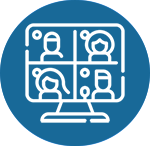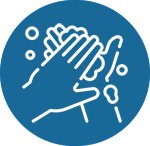ReLaunch Greater Lansing
Preparing Your Space for Reopening
Before reopening, you should sanitize your place of business to limit the spread of germs to your employees and customers. Keep this process limited to as few people as possible.
- Disinfect your business before anyone returns to work. Sanitize and disinfect all areas, giving special attention to tools, workstations and equipment, restrooms, food service areas, common surface areas, phones, computers, and other electronics.
- Replace HVAC air filters or clean/disinfect existing filters. Increase ventilation by opening windows or adjusting air conditioning.
- Put tight controls in place on who enters and exits the site during the cleaning shutdown. Limit the number of workers in the building during this time.
Communicating With Your Team
Communication during this time is incredibly important. As you prepare to reopen, share information with your employees about your plans to implement cleaning and safety protocols.
Remain available to and transparent with your employees. Have conversations with them about their concerns. Some employees may be at higher risk for severe illness, such as older adults and those with chronic medical conditions. Your team’s health is of the utmost importance, so loop employees in on your reopening strategy.
- Provide education and training materials in an easy to understand format and in the appropriate language and literacy level for all employees. This may include fact sheets and posters.
- Develop other flexible policies for scheduling and telework (if feasible) and create leave policies to allow employees to care for sick family members or care for children if schools and childcare facilities are closed.
- Strongly encourage sick employees to stay home. Develop policies that encourage sick employees to stay at home without fear of reprisal, and ensure employees are aware of these policies.
- Educate workers performing cleaning, laundry, and trash pick-up to recognize the symptoms of COVID-19. Develop policies for worker protection and provide training to all cleaning staff on-site before providing cleaning tasks.
- Talk with companies that provide your business with contract or temporary employees about their plans. Discuss the importance of sick employees staying home and encourage them to develop non-punitive “emergency sick leave” policies.
- Plan to implement practices to minimize face-to-face contact between employees if social distancing is currently recommended by the State of Michigan or the Ingham County Health Department. Actively encourage flexible work arrangements such as teleworking or staggered shifts.
Keeping the Workplace Safe

Practice Good Hygiene

Stop Handshaking & Avoid Touching Face

Increase Ventilation

Don't Share Food

Use Video Conferencing

Adjust / Postpone Large Gatherings

Stay Home if You or a Family Member is Sick

Limit Business Travel

Limit Cash Handling

Remind Staff of Hand Washing

Use Booking System to Stagger Customers

Sanitize High Traffic Areas

Hold Meetings in Open Spaces

Use Online Transactions

Communicate Covid-19 Plan with Staff

Practice Social Distancing
Personal Protective Equipment
Personal protective equipment (PPE) includes protective clothing, helmets, goggles, or other garments or equipment designed to protect the wearer from injury or infection and prevent the spread of possible infection from the wearer to others. PPE used to help prevent the spread of coronavirus may include masks, face shields, gowns and gloves. Businesses should strive to keep a minimum quantity of a 15-day supply of appropriate PPE on hand.
The State of Michigan and the Lansing Regional Chamber of Commerce have resources to assist Michigan businesses in procuring the PPE needed to reopen their facilities. Learn more.

Who Should Wear Masks?
All workers who perform in-person work or when in an enclosed space must wear a non-medical grade face covering, if medically able.

Who Should Wear Gloves?
- Those performing disinfection of common surfaces.
- Employees handling trash.
- Employees handling food.

Who Should Wear Face Shields?
Face shields are commonly used in healthcare and manufacturing. They can provide extra protection for those who must work within three feet of another person due to their job requirements. They are not necessary unless you work in healthcare/manufacturing, but they can help.
PLEASE NOTE: Gloves put employees at higher risk of exposure and are not recommended for general protective use for the following reasons:
- The COVID-19 virus does not harm your hands, so gloves provide no protection, and touching your face with contaminated hands, whether gloved or not, poses a significant risk of infection.
- Gloves often create a false sense of security for the individuals wearing them. People are more likely to touch contaminated surfaces because they feel the gloves protect them from the virus, when they do not.
- When wearing gloves, people are less inclined to wash their hands; this is counterproductive and puts others at higher risk. We want people to wash their hands because it is the number-one defense against any virus.
- Proper removal of gloves takes training. If contaminated gloves are not removed properly, employees are exposed to higher risk.
Stay Prepared
- Confirm operation has an adequate supply of soap, disinfectant, hand sanitizer, paper towels and tissues. A 15-day supply of these products is the best practice.
- Confirm stock of PPE. The State of Michigan and the Lansing Regional Chamber of Commerce have resources to assist Michigan businesses in procuring the PPE needed to reopen their facilities. Learn more.
- Have touchless thermometers on-site for employee health screenings.
Reopening Plans & Guidelines
RELAUNCH Lansing Booklet
A collaborative effort to identify best practices for Lansing regional employers to reopen operations, while ensuring the safety of employees and customers.
Covid-19 Workplace Safety
Learn more about getting Michigan back to work and safely reopening our economy by checking out our resources for your industry, or for industry as a whole.
Information for Workers and Employers
This webpage provides workers and employers with links to interim guidance and other resources for preventing exposures to, and infection with, the novel Coronavirus.
Plan, Prepare and Respond
Guidance and strategies to help prevent workplace exposures to COVID-19 for employers and employees considering or preparing for a return to the workplace.
Contact Tracing in the Workplace
Contact tracing is a public health tool that is used to help stop the spread of certain communicable diseases by identifying those who have been in close contact.
Fact Sheets
Slowing the Spread with Masks and Face Coverings
Drive Thru Testing- What You MUST Know Before You Go
Flu vs. COVID-19 vs. Common Cold
Prevention in Apartments
Tips for People Living in Close Quarters
Building Health Screening Signage
Workplace Screening Form
COVID-19 Precautions for Protesters
Wear a Mask
Masks, Social Distancing and Hand Washing Required Sign
Local Resources
You will find up-to-date resources and information on the COVID-19 pandemic. Additional information is being continually posted to our social media channels.
Essential Workplace COVID-19 Sick Employee Procedures
Do not allow the employee to come to work. Or send home immediately if indicated per the following screening:
IF THE EMPLOYEE HAS
- New or worsening cough (excluding chronic cough due to known medical reason other than COVID-19);
- Shortness of breath or difficulty breathing;
- OR at least two(2) of the following symptoms:
- Fever (100.4°F or higher) as measured by a touchless thermometer if available, but verbal confirmation of a lack of fever is sufficient if a touchless thermometer is not available;
- Chills;
- Muscle aches;
- Headache;
- Sore throat; or
- Loss of taste or smell.
Employee May Return to Work*:
- 10 days after ten symptoms started AND
- They are 72 hours symptom-free without the use of medication
Has been in close contact with an individual who tested positive for COVID-19 in the past 14 days